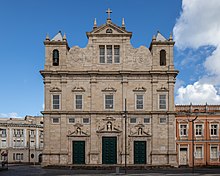| Cathedral Basilica of Salvador | |
|---|---|
Catedral Basílica de Salvador | |
 Façade of the Cathedral of Salvador, Bahia, Brazil, formerly a Jesuit church. | |
| Religion | |
| Affiliation | Catholic |
| Province | Roman Catholic Archdiocese of São Salvador da Bahia |
| Rite | Roman Rite |
| Location | |
| Municipality | Salvador |
| State | Bahia |
| Country | Brazil |
| Geographic coordinates | 12°58′22″S 38°30′37″W / 12.972897°S 38.510330°W |
| Direction of façade | Northwest |
| Designated | 1938 |
| Reference no. | 84 |
The Cathedral Basilica of Salvador (Catedral Basílica de Salvador), officially dedicated to the Transfiguration of Christ and named Primatial Cathedral Basilica of the Transfiguration of the Lord is the seat of the Archbishop of the city of Salvador, in the State of Bahia, in Brazil. The Archbishop of Salvador is also ex officio Primate of Brazil. The structure was built by the Society of Jesus as part of a large Jesuit monastic and educational complex. The current church is the built on the site, and was consecrated in 1654. After the expulsion of the Jesuits from Brazil in 1759 the school and church were transferred to the Archbishopric of Bahia. Archbishop Augusto Álvaro da Silva ordered the demolition of the existing cathedral of Salvador in 1933 to construct a tram line, and elevated the existing Jesuit structure to the status of basilica.
The cathedral is considered one of the finest examples of Mannerism in the Portuguese empire and strongly resembles the Jesuit Church of Coimbra. The façade and other elements of the structure utilize Lioz stone from Portugal. The interior of the cathedral has a large nave, elaborate baroque-style side altars, a sacristy, library, and ossuary.
The Cathedral Basilica of Salvador faces a broad plaza, the Terreiro de Jesus; is flanked by the broad Praça da Sé to the south, and overlooks the Bay of All Saints to the rear. It is a focal point of the Historic Center of Salvador, a UNESCO World Heritage Site.[1]
